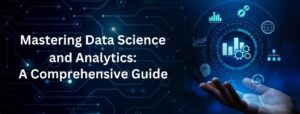
In today’s data-driven world, the ability to extract meaningful insights from vast amounts of information is a skill set in high demand. This is where Mastering in Data Science and Analytics come into play. This comprehensive guide will take you on a journey through the world of data, equipping you with the knowledge and tools to master this dynamic field.
Understanding the Fundamentals
1. Data Science vs. Data Analytics
Before diving into the intricacies, it’s crucial to understand the distinction between Data Science and Data Analytics. Data Science focuses on the entire data lifecycle, including data collection, cleaning, analysis, and visualization. On the other hand, Data Analytics primarily involves extracting insights from data sets to support decision-making.
2. The Data Lifecycle
A solid grasp of the data lifecycle is fundamental. It encompasses data collection, data preparation, data analysis, data visualization, and ultimately, data-driven decision-making. Each phase is equally crucial, and proficiency in all is essential for mastery.
Building a Strong Foundation
1. Programming Languages
Python and R are the cornerstones of Data Science and Analytics. Python’s versatility and R’s statistical capabilities make them indispensable. Familiarizing yourself with these languages will provide you with a robust foundation.
2. Statistics and Probability
A thorough understanding of statistics and probability theory is paramount. These concepts underpin the methodologies used in data analysis, enabling you to draw accurate conclusions from data.
Tools of the Trade
1. Data Manipulation and Analysis Libraries
Mastery of libraries like Pandas, NumPy, and SciPy (for Python) or dplyr, tidyr (for R) is crucial. These libraries streamline data manipulation and analysis, making complex tasks more manageable.
2. Data Visualization Tools
Tools like Tableau, Power BI, or Python libraries like Matplotlib and Seaborn are essential for creating compelling visual representations of data. Effective visualization is key to conveying insights.
Advanced Techniques
1. Machine Learning and AI
Delving into machine learning algorithms and techniques is the next step. Understanding regression, classification, clustering, and deep learning will empower you to build predictive models and make accurate forecasts.
2. Big Data and Cloud Computing
In today’s data landscape, dealing with massive datasets is common. Familiarity with technologies like Hadoop, Spark, and cloud platforms like AWS or Google Cloud is invaluable.
Practical Application
1. Real-world Projects
Hands-on experience is crucial. Engage in projects that mirror real-world scenarios. This could involve analyzing customer behavior, predicting sales trends, or solving business problems with data-driven solutions.
2. Continuous Learning and Networking
The field of Data Science and Analytics is constantly evolving. Stay updated with the latest trends, tools, and techniques by participating in online courses, workshops, and conferences. Networking with fellow professionals can also provide valuable insights and opportunities.
Ethical Considerations
1. Ethics in Data Science
Responsible data handling and analysis is imperative. Understanding privacy regulations, ensuring data security, and avoiding biases in analysis are ethical considerations that every data professional must uphold.
Conclusion
Mastering Data Science and Analytics is a journey that requires dedication, practice, and a thirst for knowledge. It’s a field that offers endless opportunities for innovation and problem-solving. By following this comprehensive guide, you’ll be well-equipped to navigate the exciting world of data and make a meaningful impact in any industry you choose. Remember, continuous learning and a passion for data are the keys to long-term success in this dynamic field.
